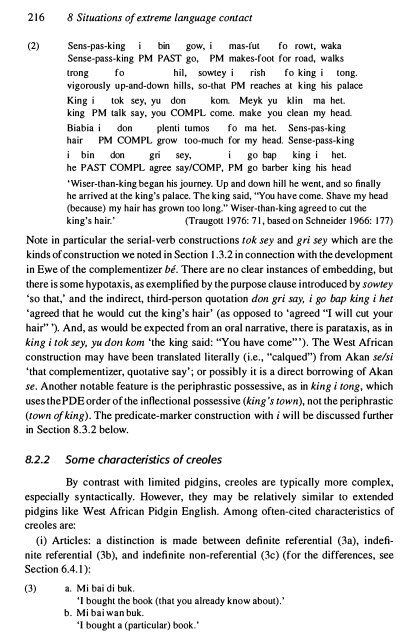Gram - SEAS
Gram - SEAS
Gram - SEAS
You also want an ePaper? Increase the reach of your titles
YUMPU automatically turns print PDFs into web optimized ePapers that Google loves.
216 8 Situations 0/ extreme language contact<br />
(2) Sens-pas-king i bin gow, i mas-rut fo rowt, waka<br />
Sense-pass-king PM PAST go, PM makes-foot for road, walks<br />
trong fo hil, sowtey i rish fo king i tong.<br />
vigorously up-and-down hills, so-that PM reaches at king his palace<br />
King i tok sey, yu don korn. Meyk yu klin rna het.<br />
king PM talk say, you COMPL come. make you clean my head.<br />
Biabia i don plenti tumos fo rna het. Sens-pas-king<br />
hair PM COMPL grow too-much for my head. Sense-pass-king<br />
i bin don gri sey, i go bap king i het.<br />
he PAST COMPL agree say/COMP, PM go barber king his head<br />
'Wiser-than-king began his journey. Up and down hill he went, and so finally<br />
he arrived at the king's palace. The king said, "You have come. Shave my head<br />
(because) my hair has grown too long." Wiser-than-king agreed to cut the<br />
king's hair.' (Traugott 1976: 71, based on Schneider 1966: 177)<br />
Note in particular the serial-verb constructions tok sey and gri sey which are the<br />
kinds of construction we noted in Section 1 .3.2 in connection with the development<br />
in Ewe of the complementizer be. There are no clear instances of embedding, but<br />
there is some hypotaxis, as exemplified by the purpose clause introduced by sowtey<br />
'so that,' and the indirect, third-person quotation dOli gri say, i go bap king i het<br />
'agreed that he would cut the king's hair' (as opposed to 'agreed "I will cut your<br />
hair" '). And, as would be expected from an oral narrative, there is parataxis, as in<br />
king i tok sey, yu dOli kom 'the king said: "You have come" '). The West African<br />
construction may have been translated literally (i.e., "calqued") from Akan selsi<br />
'that complementizer, quotative say'; or possibly it is a direct borrowing of Akan<br />
se. Another notable feature is the periphrastic possessive, as in king i tOllg, which<br />
uses the PDE order ofthe inflectional possessive (king 's town), not the periphrastic<br />
(town o/ king). The predicate-marker construction with i will be discussed further<br />
in Section 8.3.2 below.<br />
8.2.2 Some characteristics of creoles<br />
By contrast with limited pidgins, creoles are typically more complex,<br />
especially syntactically. However, they may be relatively similar to extended<br />
pidgins like West African Pidgin English. Among often-cited characteristics of<br />
creoles are:<br />
(i) Articles: a distinction is made between definite referential (3a), indefi<br />
nite referential (3b), and indefinite non-referential (3c) (for the differences, see<br />
Section 6.4. 1):<br />
(3) a. Mi bai di buk.<br />
'I bought the book (that you already know about).'<br />
b. Mi bai wan buk.<br />
'I bought a (particular) book.'
















